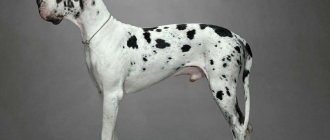Review author: “ZooVita”
This elegant, noble and devoted dog is chosen as a faithful friend and an indispensable hunting assistant, because nature has endowed him with a unique flair. Called the “gray ghost,” he fully justifies this name, possessing not only the amazing beauty of his coat, but also unsurpassed working abilities.
Description of the Weimaraner breed
Popularity 258th place among 263 dog breeds
Lifespan:
11-13 years old
Breed group:
Hounds
Height:
males: 59-70 cm, females: 57-65 cm
Country of origin:
Germany
Average price:
20-30 thousand rubles
Weight:
males: 26-32 kg, females: 23-30 kg
Latest articles Cat health
Rabies vaccination for cats: choice of vaccine, necessity, schedule 01/22/2022 4 0 0
Selection and adaptation
TOP 20 best cat breeds for families with children 01/22/2022 25 0 0
Pros and cons of this breed
Like all dog breeds, this breed has its own advantages and disadvantages.
Pros:
- good health and immunity;
- elegant appearance;
- zero aggressiveness;
- intelligence and ease of training;
- unpretentious in hair care and food;
- boundless devotion to the owner;
- gets along with children;
- excellent hunters.
Minuses:
- feel bad living exclusively indoors;
- due to the short fur, you need to wear additional clothes in winter so that the animal does not catch a cold;
- The dog’s excess energy must be released in sports and hunting, otherwise it can destroy the home interior;
- does not tolerate loneliness well if the owner leaves for a long time;
- security potential is low;
- stubbornness and independence in decisions.
Key facts
Weimaraners are unique ash-gray animals with amber-colored eyes. This combination makes the dog’s appearance memorable and unusual.
The Weimaraner dog was bred for hunting purposes, so it has proven itself excellent in hunting animals and birds. The German Pointer is also known for its hypersensitive sense of smell.
“Hounds respond well to training, but without proper training they become simply uncontrollable.
Noble dogs serve in the police of a number of European countries; they are also among the “employees” of the Ministry of Emergency Situations in Germany.
The German pointer categorically does not like loneliness, so he prefers to spend as much time as possible with his owner and his family members.
Varieties of colors
The standard includes the following colors:
- silver gray;
- fawn gray;
- mouse gray;
- transitions between these shades.
History of the origin of the Weimaraner breed
Intelligent appearance and excellent hunting qualities have given rise to various legends about the appearance of these noble pets. In literary works and documents there are references to the German cop dating back to the 13th century. However, dogs officially received their recognition only in 1869.
It is known that representatives of this breed were favorite pets of the European nobility. They became favorites after the return of Louis IX from the unsuccessful crusade. In the works of Gaston de Foix it is written that the monarch returned home and brought a pack of more than 10 blue-gray dogs. The animals instantly acquired the noble status of “blue blood” pets.
The name of the breed, specially bred in the suburbs of Weimar in East Germany, was first officially mentioned only in 1850. But German breeders of those years did not want to recognize the ash-gray individuals as a separate breed, positioning them as a hybrid.
Only 30 years later the first Weimaraners began to take part in exhibitions and acquired the status of an independent individual. In 1897, a kennel club dedicated to this breed appeared in Germany. At that time, it was impossible to buy Weimaraner or Weimar Pointer puppies outside the country.
In 1928, Howard Knight, a hunting enthusiast and sportsman from New England, was able to take several representatives to the United States. The first American cops were born almost a decade later. In 1943, the breed received official recognition from local breeders. In a short time, German Weimaraners became very popular in the United States. So, as of 2022, they rank 39th in the ranking of the most popular dogs in America.
Breeds Similar to the Gray Ghost
Similarities in appearance can be seen between the short-haired Weimar Pointer and the Hungarian Vizsla.
Weimaraner VS Vizsla
Wemaraners have similar features to German pointers - Langhaar and shorthaired pointer, all three breeds are hunters and come from Germany, but the color will not allow them to be confused and, of course, for connoisseurs of the breeds, the differences in the exterior are obvious.
Weimaraner VS Kurzhaar
Weimar Pointer VS Langhaar
Appearance of the Weimaraner
General impression
Noble animals are among the largest representatives. They have an athletic build with powerful muscles. The elegant individual has a sophisticated appearance, which eloquently testifies to the hunting skills of a Weimaraner pointing dog.
Head
The head is of medium size. It is proportional, with a rounded nape, on which there is a small tubercle. The wide forehead has a pronounced dividing groove. When a Weimaraner dog concentrates on something, folds of skin form on its forehead.
Nose, eyes and ears
The eyes are of medium size. They are neat, round in shape, with slightly raised outer corners and dry eyelids of flesh or fur color. Puppies have bright blue irises, while adult dogs have amber irises.
The nose is large, darkly pigmented. The chewing muscles are developed, the eyebrow arches are mobile. The stop is of moderate type, merging into a smooth nose, with a small fold near the lobe.
The ears are large, triangular, round, located relatively close and high. The cartilages are moderately soft. When the animal is calm, the ears hang freely on the sides of the head. If an individual is alert or focusing on something, they rise slightly and turn forward.
Teeth and bite
The jaw is strong, with a full set of medium-sized white teeth that form a regular scissor bite.
Neck
The neck is of medium length. She is all covered with strong muscles. The neck thickens towards the shoulders, and then flows smoothly into a well-defined withers.
Torso
The body is moderately elongated. The animal's back is straight and wide, turning into a short waist and powerful croup. The chest is deep, not very wide, but with rounded and powerful ribs.
Forelegs
The animal's paws are long, with dry muscles. The forelimbs are located parallel to the body. Shoulders are strong, elbows straight, not turned in or out. The middle finger is longer, so it stands out in appearance. This is not a disadvantage, but removal of the dewclaws is necessary. Their presence is not welcomed by standards.
Hind limbs
The hind legs are strong, long, with powerful muscles. They are directly placed. The thighs are very muscular, with strong stifles and pronounced hocks.
Tail
The tail is slightly thickened at the base, but tapers towards the end. In a calm state it is located low. If the animal is excited, the tail rises to the level of the back or slightly higher. It should not bend, touch the back or lie on the croup.
Movements
Weimars are wonderful hunters, they are agile, fast, and can move almost silently. When moving, individuals place their front and hind limbs parallel to each other. Moving at a gallop, pointers make long jumps.
Wool
German pointers have short, smooth fur. They have no undercoat, which makes them quite easy to care for. Despite the ease of care, short hair and lack of undercoat, this breed sheds. Dogs are not hypoallergenic, which is bad news for allergy sufferers.
Color
Color is the calling card of the breed. Shades from silver to mouse gray are allowed. The dog's head and ears may be somewhat lighter; white spots on the chest and paws are not excluded by the standard.
Size
Among their species, these are the largest animals, the height of males varies from 59 to 70 cm, females - from 57 to 65 cm. The weight of males can be from 30 to 40 kg, females - from 25 to 35 kg.
Disqualifying faults
An experienced breeder can determine from a photo of a Weimaraner dog what deviations from the standard a particular representative of the breed has. First of all, the head of the animal attracts attention. It should not be bulldog type, too short or, conversely, with an excessively narrow and pointed shape.
Other deviations from the standard:
- the back is irregularly shaped - sunken or hunched;
- the stomach is very tucked;
- limbs with turned elbows and flat paws;
- underdeveloped or barrel-shaped chest;
- nose with a concave back;
- fluffy coat in short-haired individuals;
- scorch marks.
A disqualifying fault is a shade that is too intense, which can displace the gray color. A deviation for representatives of this breed will be excessive nervousness and cowardice. If the Weimaraner lacks temperament, this also becomes a serious disqualifying fault.
Weimaraner character
The character of representatives of this breed depends on upbringing and training; The owner's attitude towards his four-legged friend is also of great importance. With the right approach, a pet with an obedient character grows up. But without education, pets become hyperactive destroyers.
Four-legged animals very quickly become attached to family members. They are overly loyal. With its owner, the pet will go to any place without hesitation for a second.
The four-legged friend endures loneliness hard. But he is wary of strangers. An individual without socialization can show timidity and fearfulness, as well as aggression.
A pet does not immediately accept new people; it takes patience and time to get used to strangers. Representatives of this breed do not have watchdog qualities. But they can notify about the approach of strangers by barking loudly.
The Weimaraner combines the qualities of a hunter and a companion. Most purebreds get along well with children - they love to spend time together, play and run. Children's pranks are forgiven; your four-legged friend will not bite back. But too intrusive attention from children can cause discomfort in the animal.
If there is a small child and a growing puppy in the house, you need to be on guard. An overly active animal can knock over or drop its small owner.
The presence of other animals in the home can cause a number of problems. Socialized Weimaraners will be polite to their relatives, cats, and birds. If there are 2 puppies growing in the house, especially of different sexes, they will quickly get used to each other. However, males will try to dominate. They will not fight to the last drop of blood, but conflicts are inevitable.
These dogs are aggressive towards other animals. They were originally intended for hunting, so dogs will always show the instincts given by nature, regardless of who is chosen as prey - a guinea pig or a deer.
Poll: What is your Wemaraner?
Friendliness
Loves everyone. Even strangers are perceived with a smile, what if this is a new playmate.
50%
Treats all family members and close friends well. Restrained with strangers.
50%
He loves “his pack” (me/my family) very much, but is cold and wary with strangers.
0%
Voted: 4
Temperament
Very emotional, playful, we can only dream of peace.
75%
He loves to run and fool around, but can also rest peacefully in his favorite place.
25%
Apparently my weim is a philosopher. Loves quiet walks, lying on the grass or in front of the TV.
0%
Voted: 4
Stubbornness
Very obedient, we found mutual understanding and now there can be no talk of any stubbornness.
25%
There are some commands that he does not like to carry out, but you can come to an agreement with him.
50%
Obedience is not easy for us, but we do not give up - the dog in his stubbornness, and I in my desire to overcome it.
25%
Voted: 4
Relationship with other dogs
He has many four-legged friends and loves to play and run.
60%
Indifferent to other people's dogs.
20%
Does not like others, may even growl.
20%
Voted: 5
Education and training
Representatives of this breed have excellent working qualities, and training in this direction presents practically no difficulties. The Weimaraner loves to hunt and obeys all commands with pleasure. However, your pet can easily master the basic skills program.
The main thing is to remember that during training you cannot use physical force or shout. In this case, your four-legged friend may completely refuse to follow commands. But representatives of this breed love praise: they immediately begin to obediently obey and please.
The Weimar is very intelligent, so he can be stubborn and willful. In case of disobedience, the pet may do everything wrong - or even ignore the owner’s request. This will require behavioral adjustments.
The German cop listens only to the person whom he perceives as a leader. But as soon as the owner gives in, the pet immediately begins to dominate, and this is difficult to fight. It is much easier to avoid such moments.
It is not recommended for beginners to have such a dog. If you don't socialize your dog and become an authority figure for him, you can run into a lot of problems.
Wayward pets are active, mobile, tireless - so the owner will have to devote a lot of time to walks, activities and games. The dog can run for a long time, being an ideal companion for lovers of an active lifestyle.
Mention of the Weimar cop
US President Dwight Eisenhower was given an adorable Weimaraner puppy in 1955 and for many years, Heidi, according to a personal letter from the president, “has been an asset to the White House... she is beautiful and well-behaved (she is sometimes prone to stubbornness, but then immediately apologizes about it) ... and she is extremely affectionate and seemingly happy.” True, a few years later Heidi left Washington and moved to live on a farm, where she was no less happy as the mother of four puppies.
Grace Kelly, a Hollywood actress and Princess of Monaco, adored animals - the Weimaraner Oliver was given to her for her wedding and lived for many years in the family of the Prince of Monaco as a member of the family.
The most famous Weimaraner is Man Ray, the dog of photographer William Wegman. In 1982, journalists named Man Ray “man” of the year, successfully playing on the sound of the dog’s name and the English “man”. Wegman's photographer, having accidentally photographed a Weimaraner in the frame, was surprised by the almost human emotion on the dog's face and for many years made him the central figure of his photographs and videos.
Over the years, more than twelve dogs worked with the photographer, whose work again raised Weimaraners to the peak of popularity in America and other countries. In 1988, Wegman's dogs appeared on the famous international educational children's program "Sesame Street" - they successfully added the letters of the alphabet and taught children to count from 1 to 9.
Movies with Weimaraners
- Best in Show (2000)
- Daylight (1996)
- Alphabet Soup (1995)
Weimaraners are also popular in various commercials, music album covers, and movie posters.
1 Music album Kate Bush (Hounds of Love); 2 Weimaraner Art Movie Poster The Blue Angel
Weimaraner health and illness
Possible diseases
The average life expectancy of a German pointer is about 11-13 years. Pets are characterized by hereditary ailments, but not acquired ones. More often dogs suffer from:
- idiopathic osteodystrophy (“skeletal scurvy”);
- hip dysplasia;
- stomach and intestinal torsions;
- dystrophic changes in the cornea;
- tumor formations of various origins (lipoma, fibrosarcoma, melanoma, mastocytoma);
- inflammatory processes in bone tissue;
- demodicosis;
- inflammation of the interdigital skin;
- complete or partial cryptorchidism.
- von Willebrand's disease.
In addition to all of the above, Weimar cops have a high risk of developing autoimmune reactions to a number of immunobiological drugs. To reduce the risk of getting the disease, veterinarians recommend vaccinating your pet at intervals of 2 weeks against parvovirus and canine distemper.
Such an abundance of congenital or acquired pathologies is due to the fact that for a long time breeders worked to improve the aesthetic characteristics of Weimaraners, without caring about the internal state of the hounds. Modern breeders are engaged in improving the health of animals.
Reproductive health and breeding
Mating of a female and a male is possible only after all the reproductive organs of the animals are fully formed. Early mating is contraindicated because it can cause various diseases.
“ More about mating in dogs
The optimal time for reproduction in females is considered to be 20 months and older, in males – 24 months and older. According to veterinarians, the female reaches sexual maturity after her third heat.
Features of feeding and diet
A balanced diet is the key to good physical shape and a beautiful coat for a German pointer. When feeding naturally, the pet should receive the following products:
- lean meat;
- offal;
- small-bone sea fish;
- fermented milk products (kefir, cottage cheese);
- cereals (buckwheat or rice);
- vegetables, greens;
- fruits.
The menu should be balanced, and vitamin-mineral complexes should be added to the diet. To improve intestinal functions, veterinarians recommend adding 1 tablespoon of vegetable oil to food.
Another option is to feed your pet ready-made industrial food. The main thing is that the product is premium or super-premium. It is necessary to adhere to the recommended dosage, since it is not worth overfeeding German cops.
It is important to provide your pet with plenty of clean drinking water - these dogs consume a lot of liquid regardless of the type of feeding.
The amount of food and portions is determined by the age of the four-legged friend:
- up to 2 months – 6 feedings per day;
- from 4 months – 4 feedings;
- from six months – 3 feedings;
- from 9 months – 2 feedings per day.
A dog's nutrition is an important component of health, so giving food from your table is strictly prohibited.
Dog movement and loads
All descriptions of the Weimaraner breed speak of the independence of this breed and the need for significant physical activity.
The ideal option for such a dog would be to live in a separate private house, where it can walk to its heart's content during the day and get impressions in the local area, and spend the night indoors.
When kept in an apartment, the dog should walk for about two hours every day.
It is necessary to choose a place for walking where the dog can gallop, jump or run with its famous measured gait.
Care and maintenance
Hygiene
Germans are easy to care for. This is a rather unpretentious animal. which, however, is important to keep clean. Mandatory procedures for caring for a four-legged animal are:
- Combing.
A short-haired individual should be groomed with a natural bristle brush or a special glove on average 1-2 times a week.
- Bathing.
Water treatments should be carried out monthly with a special shampoo for smooth-haired individuals. During the winter months, you can use dry shampoo.
- Cleansing ears and eyes.
They should be washed with chamomile decoction or warm boiled water once a week.
- Teeth cleaning.
The procedure must be carried out twice.
- Nail trimming.
The procedure must be carried out at least 2 times a month.
- Cleaning paws.
Washing should be done immediately upon returning home. This is especially important in winter to prevent the dog from licking its paws and getting poisoned by the reagents. And to avoid cracks, the pads should be lubricated with vegetable oil.
- Deworming.
It must be carried out once a quarter.
Weimaraners are prone to developing a number of diseases. Among them there is a dangerous disease - piroplasmosis. The carriers of this disease are ticks and fleas. Immediately after walks, your four-legged friend should be carefully examined for the presence of skin parasites.
From the first days of its arrival in the family, the pet should be provided with separate dishes or toys.
Why do you need clothes?
In the autumn-winter season, the Weimar pointer must be dressed in warm clothes. These individuals do not have an undercoat that can protect them from frost.
Where to keep it: in a house or an enclosure?
Breeders do not recommend locking your pet in an enclosure. He needs freedom and the opportunity to run. A four-legged friend can live in an apartment, but a bored pet that does not receive enough exercise becomes a threat to interior items.
The ideal option for keeping German hounds would be a country house. In this case, the four-legged pet will be able to freely walk around the yard and the surrounding area - if they are safe.
When walking outside, you must keep your pet on a leash - the animal may, upon seeing a cat or other animal, feel agitated and run away.
Nutrition
This breed does not cause allergies, so nutrition, if we are talking about the natural type of feeding, can be varied. The main rule is a balanced diet. Microelements are already included in dry food. But with natural food, the dog may receive an insufficient amount of vitamins. Therefore, supplements are recommended. It is imperative that the composition includes proteins such as meat, sea fish or offal.
Moreover, almost all varieties of meat are recommended, except pork. Complex carbohydrates are also very important. And not only buckwheat and rice, but also oatmeal. Potatoes are undesirable among vegetables, and other products are served boiled or raw, or can be given grated.
Once or twice a week, the dog can be fed with boiled eggs of chickens or quails. The dog will not refuse fermented milk products such as low-fat natural yogurt, kefir or fermented baked milk.
By the way, Weimaraner puppies should consume “sour milk” daily, at least until they are 5-6 months old. But an adult dog can be given kefir and fermented baked milk less often. Otherwise, intestinal disorders may occur. The principle of feeding is that the volume of food should correspond to the size and age of the dog. Weimaraners are prone to overweight and weight gain.
Therefore, owners should have a negative attitude towards “biting” between meals. After eating, it is better to remove the bowl until the next feeding. But the bowl of water should always be in a visible and accessible place for the dog.
Tips for choosing a puppy
You can’t buy a Weimaraner puppy in Russia everywhere. Today there are nurseries in Moscow, St. Petersburg, Volgograd, Tambov and Novosibirsk. This is where you can buy a purebred Weimaraner puppy. It is not recommended to buy a pet from unverified breeders.
When choosing a Weimaraner puppy, pay attention to:
- neatness of the premises;
- diet of cubs and mother;
- parents' appearance;
- veterinary passport of the baby and mother.
Since this breed is prone to some congenital diseases, it is advisable to obtain test results for joint dysplasia and other pathologies from the breeder.
Links[edit]
- ^ abcdefg "Weimaraner Standard" (PDF). FCI. Retrieved April 25, 2022.
- O'Neill, CEO; Church, DB; McGreevy, P.D.; Thomson, PC; Broadbelt, D. C. (2013). "Longevity and Mortality of Domestic Dogs in England" (PDF). Veterinary Journal
.
198
(3):638–43. DOI: 10.1016/j.tvjl.2013.09.020. PMID 24206631. "n=26, median=12.6, IQR=11.1–13.5" - "Weimaraner". Kennel Club. Retrieved December 26, 2016.
- Deep, John. "Weimaraner". 2 puppies
. Retrieved December 26, 2016. - Kočov, Dr. Jan. "History of the Weimaraner Breed". Royal splendor
. - Weimaraner Paige
- Taguchi, Ann. "Smart Cones, Garrasburg Horns and Other Weimaraner Features". JustWeimaraners
. Taguchi, Ann. - ^ ab "Weimaraner: The Pros and Cons of Owning a Weimaraner". Pettium.
- "Phase IV: Troubleshooting Your Mission: Dealing with Problem Behavior". Weimaranians Adonai.
- "Weimaraner". OFFA.
- Abdominal bloat testing (GDV)
- ^ abcde "List of common problems encountered by Weimaraners". Weimaraner Club of America.
- FITZPATRICK, NOEL; SMITH, THOMAS J.; EVANS, RICHARD B.; YADON, RUSSELL (February 2009). "Radiographic and arthroscopic findings in the elbow joints of 263 dogs with medial coronoid disease". Veterinary surgery
.
38
(2):213–223. DOI: 10.1111/j.1532-950X.2008.00489.x. PMID 19236680. - ^ abcde "Weimaraners". Database on hereditary diseases of dogs. Archived from the original on February 19, 2007.











